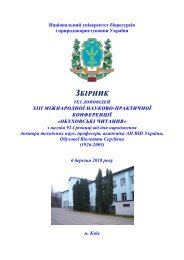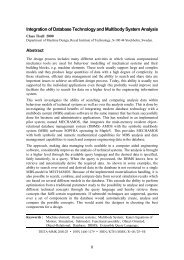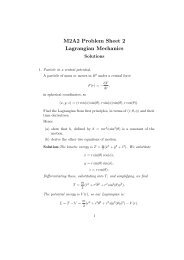на ПРУЖИНАХ !!!!!!!!!!!!!!!!!!!!!!!!!!!!!!!!
You also want an ePaper? Increase the reach of your titles
YUMPU automatically turns print PDFs into web optimized ePapers that Google loves.
Applied Mechanics and Materials Vols. 110-116 (2012) pp 2762-2767<br />
Online available since 2011/Oct/24 at www.scientific.net<br />
© (2012) Trans Tech Publications, Switzerland<br />
doi:10.4028/www.scientific.net/AMM.110-116.2762<br />
Running Model for a Compliant Wheel-Leg Hybrid Mobile Robot by<br />
Using a Mass-Spring Model<br />
Youngshik Kim 1, a and Dong-Hwan Shin 2, b<br />
1 Department of Mechanical Engineering, Hanbat National University, Daejon, 305-719, Korea<br />
2 Division of Robot System, DGIST, Daegu, Korea<br />
a youngshik@hanbat.ac.kr, b sdh77@dgist.ac.kr<br />
Keywords- mass-spring model; passive compliant joints; running; swing control; wheel-leg hybrid<br />
mobile robot<br />
Abstract—This research presents a running model for a compliant wheel-leg hybrid mobile robot.<br />
A wheel-leg consists of three legs arranged by 120 degrees to each other and passive compliant<br />
joints. For simplicity, each leg is treated as a linear spring such that a traditional mass-spring model<br />
can be applied to model running of the wheel-leg hybrid robot. In order to achieve stable running,<br />
we propose a simple controller that can converge a robot leg to a desired angle of attack<br />
asymptotically during the swing phase. Hybrid wheel-leg running is then simulated and results are<br />
discussed.<br />
I. INTRODUCTION<br />
For decades, many researchers have adopted legs and wheels to provide mobility for robots [1-5].<br />
However, mobility of legged and wheeled robots are critically limited to ground conditions and<br />
environment. For instance, wheeled robots can move efficiently on high traction surfaces whereas<br />
legged robots provide good performance on rugged terrain. For these reasons, hybrid mobile robots<br />
combining wheels and legs at the same time have drawn many researchers’ attention to maximize<br />
robot mobility in all terrain.<br />
A unicycle type model [6] is significantly used to describe wheeled mobile robot. In contrast,<br />
several types of model are available in legged robots according locomotion and speed; minimal<br />
model of walking, synthetic wheel, and mass-spring model of running [7]. Passive compliant joints<br />
are also applied to reject disturbances, increase energy efficiency, and/or provide advanced<br />
maneuverability in some robots . Traditionally, linear or torsional spring systems have been used to<br />
describe these compliant joints [8, 9].<br />
Furthermore, it is well known that the simple<br />
mass-spring model, so called Spring Loaded<br />
Inverted Pendulums (SLIPs) [8], can demonstrate<br />
running dynamics of animals and humans<br />
effectively. In the mass-spring model, a leg is an<br />
ideal linear spring of negligible mass. The robot<br />
body is then described by a point mass mounted<br />
on the leg. Thus, kinetic and potential energy of<br />
this system is conserved supposing a perfect<br />
spring and no air resistance such that the transport<br />
cost will be zero in an ideal world.<br />
Recently, we are developing a novel wheel-leg<br />
hybrid robot, Fig. 1, with passive compliant joints<br />
inspired by animal and human legs [10]. Most<br />
importantly, compliance in the leg is adopted to<br />
provide energy-efficient running similar to<br />
Fig. 1. Wheel-leg hybrid mobile robot with<br />
passive compliant joints<br />
All rights reserved. No part of contents of this paper may be reproduced or transmitted in any form or by any means without the written permission of TTP,<br />
www.ttp.net. (ID: 130.203.136.75, Pennsylvania State University, University Park, USA-10/03/15,09:22:00)
Applied Mechanics and Materials Vols. 110-116 2763<br />
animals storing kinetic energy as elastic energy during passive motion. In this research we are<br />
interested in simplified robot modeling and control for high speed locomotion similar to animals and<br />
humans. Thus, we present how our novel wheel-leg with compliance can be modeled for running by<br />
using the simple mass-spring model (SLIP) and a controller, which is the main contribution of this<br />
research.<br />
This paper is organized as follows: In Sec. II, we present a wheel-leg hybrid robot model<br />
considering dynamics and kinematics. We then verify the proposed wheel-leg robot in simulation<br />
and discuss simulation results in Sec. III. Finally, Sec. IV provides conclusions of this research and<br />
future work.<br />
II.<br />
RUNNING MODEL<br />
A hybrid wheel-leg is modeled by using a traditional spring-mass system. Applying the spring<br />
loaded inverted pendulum model, inertia and mass of a leg is assumed to be negligible. The robot<br />
body is then treated as the point mass, m. In this case, three identical compliant leg segments are<br />
attached to the body and separated by 120 degrees as shown in Fig. 2.<br />
Fig. 2. Hybrid wheel-leg modeling<br />
Running of the wheel-leg system can be divided into swing and stance phases as shown in Fig. 3<br />
similar to the SLIP model. It is, however, worthwhile to note that our wheel-leg rotates in a fixed<br />
direction for forward motion similar to a wheel whereas a leg move back and forth periodically to<br />
satisfy desired angles of attack.<br />
First, considering the particle dynamics of mass, m, in Cartesian coordinates, (x 0 , y 0 ), during the<br />
swing phase where only gravity is acting, we have,<br />
x = 0<br />
0<br />
y<br />
0<br />
= −g<br />
, (1)<br />
where m represents the mass of the robot and g is the gravity. Similarly, considering the stance phase<br />
when the leg i (i=1,2,3) rolls about a fixed point on the ground, we then have,<br />
k<br />
x0 = ( L0<br />
− Li<br />
)cos( θi<br />
) ; i = 1,2,3<br />
m<br />
k<br />
y0 = ( L0<br />
− Li<br />
)sin( θi<br />
) − g<br />
m<br />
, (2)
2764 Mechanical and Aerospace Engineering, ICMAE2011<br />
where coordinates (x i , y i ) represent the position of a foot point of the leg i, L 0 is the undeformed<br />
length of the leg, L i is the length of the leg i, and θ i is an angle measured from the x-axis that is<br />
parallel to the ground as defined by,<br />
L = ( x − x ) + ( y − y )<br />
θ<br />
2 2<br />
i i 0 i 0<br />
tan<br />
⎛ y<br />
− y ⎞<br />
−1 0 i<br />
i<br />
= ⎜ ⎟<br />
x0<br />
− xi<br />
Foot positions of legs are then defined by,<br />
⎝<br />
⎠<br />
. (3)<br />
x = x + L cos( β )<br />
i 0 i i<br />
y = y + L sin( β )<br />
i 0 i i<br />
, (4)<br />
where β 1 =β, β 2 =β +2π/3, β 3 =β −2π/3, and<br />
β<br />
β<br />
− y y<br />
tan<br />
⎛ − ⎞<br />
⎝ ⎠<br />
1 1 0<br />
=<br />
1<br />
= ⎜ ⎟<br />
x1 − x0<br />
. (5)<br />
Furthermore, the angle of attack, θ*, Fig. 3, should be determined to provide stable motion. In this<br />
case, robot motion is stable if the robot moves without falling on the ground. Toward this goal,<br />
Rummel and Seyfarth [8] investigated self-stability and self-stable running as a function of robot<br />
properties (leg length, mass, and joint stiffness), running speed, and angle of attack. As a result,<br />
they illustrated several regions of these properties for stable running. If robot parameters are selected<br />
in these stable regions, the robot is supposed to keep running without falling. Thus, we will choose<br />
the angle of attack which satisfies the aforementioned regions of stable running for given robot<br />
parameters for evaluation in Sec. III.<br />
Now we discuss how we can achieve desired orientation of the wheel-leg for stable running.<br />
During the swing phase, the wheel-leg must rotate one of its leg to the desired angle of attack before<br />
this leg touches down the ground. Toward this goal, we need to control angular velocities of the<br />
wheel-leg. For asymptotical stability [11], we apply the following controller during the swing phase,<br />
θ = − tanh( θ −θ*)<br />
, (6)<br />
i<br />
K θ<br />
i<br />
v y<br />
Swing phase<br />
Swing phase<br />
Trajectory path of<br />
the center of mass<br />
v x<br />
Stance phase<br />
L
Applied Mechanics and Materials Vols. 110-116 2765<br />
y(m)<br />
1.5<br />
0.5 1<br />
t=0<br />
0 5 10 15 20 25 30<br />
x (m)<br />
Vy<br />
Vx<br />
Fig. 4. Running trajectory path of the center of mass and sequential positions of the wheel-leg<br />
y cos( θ ) − x sin( θ )<br />
θ = <br />
0 i 0 i<br />
i<br />
(7)<br />
Li<br />
Note that self-stability of legged robots physically depends on how angular momentum and<br />
gravity of the center of mass are balanced during the stance phase to move without falling. Thus, it is<br />
worthwhile to investigate robot energy during motion. The total energy of the robot consists of<br />
kinetic, gravitational potential, and elastic potential energy,<br />
E E E E<br />
= + + , (8)<br />
Kinetic Potential, Gravity Potential , Elastic<br />
where<br />
m<br />
EKinetic<br />
= x + y<br />
2<br />
E = mgy<br />
2 2<br />
( <br />
0 0 )<br />
Potential, Gravity 0<br />
k<br />
EPotential, Elastic<br />
= L0<br />
− Li<br />
2<br />
( )<br />
2<br />
. (9)<br />
Note that the total energy (8) is conserved in the mass-spring model with an assumption of negligible<br />
leg mass and no disturbance, which will be verified in the next section.<br />
III. SIMULATION RESULTS AND DISCUSSIONS<br />
A. Methods<br />
First, we assume an ideal simulation environment with a perfect model and no disturbance as<br />
mentioned in Sec. II. The robot parameters used in this research are as follows; m=80 kg, L 0 =1 m,<br />
θ*=112 degrees, k=20000 N/m, K θ =50. As discussed in Sec. II, this angle of attack satisfies selfstability<br />
for running according to [8] with the following initial condition for the center of mass;<br />
position [x 0 (t=0), y 0 (t=0)]=[0, 1 m] and velocity [v x (t=0), y y (t=0)]=[5 m/sec, 0].<br />
We simulate the proposed leg-wheel hybrid by using Matlab with tolerances of 1 ×10 -12 . Note that<br />
running is divided into two phases for a single step whose governing dynamics are different, but<br />
robot path trajectories are piecewise continuous.<br />
B. Simulation Results<br />
Now we present running simulation results, Fig. 4 and Fig. 5, applying the aforementioned robot<br />
parameters. The robot trajectory path, Fig. 4, illustrates the motion of the center of robot mass. As<br />
expected, this result demonstrates that the wheel-leg robot runs stably and smoothly similar to the<br />
SLIP model. Note that the wheel-leg rotates clockwise to move forward (the positive x direction)<br />
during the swing phase, which is different from the motion of a single leg used in the SLIP model as<br />
discussed in Sec. II.
2766 Mechanical and Aerospace Engineering, ICMAE2011<br />
L (m)<br />
1<br />
0.9<br />
L1<br />
L2<br />
L3<br />
Velocity (m/s)<br />
Control input<br />
(rad/sec)<br />
Energy (Nm)<br />
0.8<br />
0 1 2 3 4 5 6 7<br />
Time (sec)<br />
(a) Leg length<br />
6<br />
Vx<br />
4<br />
2<br />
0<br />
-2<br />
0 1 2 3 4 5 6 7<br />
Time (sec)<br />
(b) Robot velocity<br />
0<br />
-20<br />
-40<br />
-60<br />
0 1 2 3 4 5 6 7<br />
Time (sec)<br />
(c) Control input<br />
2000<br />
1500<br />
1000<br />
500<br />
Total<br />
Kinetic<br />
Potential(gravity)<br />
Elastic potential<br />
0<br />
0 1 2 3 4 5 6 7<br />
Time (sec)<br />
(d) Energy<br />
Fig. 5. Simulated wheel-leg hybrid running<br />
Fig. 5 (a)-(d) show change in leg lengths (L 1 , L 2 , L 3 ), velocities of the center of mass, control<br />
input for the swing phase, and system energy, respectively. A leg is compressed while contacting<br />
with the ground. The amount of this leg deflection varies slightly for each step, but the maximum<br />
deflection is estimated to be ~25% of the undeformed length. The average speed of the robot in the<br />
x-direction is ~ 5 m/sec, which is almost same as the initial speed whereas vertical speed changes<br />
similar to a bouncing ball. Our results also show that the control input bounded by K θ ca rotate the<br />
leg to the desired angle of attack as designed. Finally, we find that total energy is conserved for<br />
wheel-leg hybrid running as discussed in Sec. II. In this case, kinetic energy (49.8%~60.1%) and<br />
gravitational potential energy (37.3%~44.4%) are significant when compared to total energy of<br />
1784.8 Nm whereas elastic potential energy (0~12.9%) is relatively small.<br />
Vy<br />
IV. CONCLUSIONS<br />
In this research we model a novel compliant wheel-leg hybrid robot based on a simple massspring<br />
model. We also propose a controller that can converge the wheel-leg to a desired angle of<br />
attack asymptotical during the swing phase. As a result, our simulation results verify that our hybrid<br />
wheel-leg can run efficiently similar to the ideal SLIP model where leg mass and inertia are<br />
negligible.<br />
Future work will focus on extension of the proposed running model considering masses and<br />
inertia effects of wheel-legs, which will allow us to investigate more realistic robot and ground<br />
conditions.
Applied Mechanics and Materials Vols. 110-116 2767<br />
ACKNOWLEDGMENT<br />
This research was supported by the Hanbat National University, Daejon, Korea.<br />
REFERENCES<br />
[1] E. Z. Moore, D. Campbell, F. Grimminger, and M. Buehler, "Reliable stair climbing in the<br />
simple hexapod 'RHex'," Proceedings 2002 IEEE International Conference on Robotics and<br />
Automation, 11-15 May 2002, Piscataway, NJ, USA, pp. 2222-7, 2002.<br />
[2] A. S. Boxerbaum, J. Oro, and R. D. Quinn, "Introducing DAGSI Whegs: the latest generation of<br />
Whegs robots, featuring a passive-compliant body joint," 2008 IEEE International Conference<br />
on Robotics and Automation. The Half-Day Workshop on: Towards Autonomous Agriculture of<br />
Tomorrow, 19-23 May 2008, Piscataway, NJ, USA, pp. 1783-4, 2008.<br />
[3] G. Quaglia, D. Maffiodo, W. Franco, S. Appendino, and R. Oderio, "The Epi.q-1 hybrid mobile<br />
robot," International Journal of Robotics Research, vol. 29, pp. 81-91, 2010.<br />
[4] C. Steeves, M. G. Buehler, and S. G. Penzes, "Dynamic behaviors for a hybrid leg-wheel mobile<br />
platform," Unmanned Ground Vehicle Technology IV, 2-3 April 2002, USA, pp. 75-86, 2002.<br />
[5] Y. Kim and M. A. Minor, "Coordinated kinematic control of compliantly coupled multirobot<br />
systems in an array format," IEEE Transactions on Robotics, vol. 26, pp. 173-180, 2010.<br />
[6] Y. Kim and M. A. Minor, "Path manifold-based kinematic control of wheeled mobile robots<br />
considering physical constraints," International Journal of Robotics Research, vol. 26, pp. 955-<br />
975, 2007.<br />
[7] R. M. Alexander, Principles of Animal Locomotion: Princeton University Press, 2006.<br />
[8] J. Rummel and A. Seyfarth, "Stable Running with Segmented Legs," The International Journal<br />
of Robotics Research, vol. 27, pp. 919-934, 2008.<br />
[9] S. Rutishauser, A. Sprowitz, L. Righetti, and A. J. Ijspeert, "Passive compliant quadruped robot<br />
using central pattern generators for locomotion control," 2008 2nd IEEE RAS EMBS<br />
International Conference on Biomedical Robotics and Biomechatronics. BioRob 2008, 19-22<br />
Oct. 2008, Piscataway, NJ, USA, pp. 710-15, 2008.<br />
[10] D.-H. Shin, Y. Kim, O.-S. Kwon, D.-U. Kong, and J. An, "A Study of Two Segmented Leg<br />
for a Biologically Inspired Mobile Robot for Rugged Terrain," Conference for Korean Society<br />
for Precision Engineering, Jeju, Korea, pp. 1271-1272, 2010.<br />
[11] H. K. Khalil, Nonlinear Systems (3rd Edition): Prentice Hall, 2001.
Mechanical and Aerospace Engineering, ICMAE2011<br />
10.4028/www.scientific.net/AMM.110-116<br />
Running Model for a Compliant Wheel-Leg Hybrid Mobile Robot by Using a Mass-Spring Model<br />
10.4028/www.scientific.net/AMM.110-116.2762







